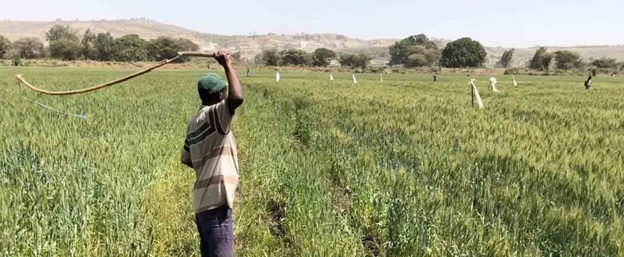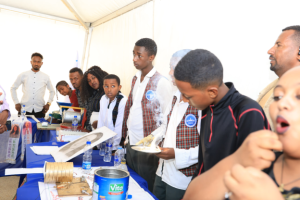
COMPILED BY DARGIE KAHSAY
Ethiopia is a large country with still having large uncultivated land. Its agricultural production though hasn’t even satisfied local demand. Wheat production in particular has been low as it is importing from abroad to satisfy local demand. The potential especially the wide uncultivated arable land was for time overlooked. Dryness of the region having low rainfall and disuse of modern irrigation systems made these potential left untapped up to this time.
Prime Minister Abiy Ahemd administration however didn’t take time to realize this. In a bid to radicalize the agriculture sector, Prime Minister Abiy introduced a campaign to increase wheat production especially by exploiting the vast untapped in lowland areas of Ethiopia. The initiative is just poised to fulfill local demand but it was an ambitious dream of making Ethiopia famous wheat exporter. In order to achieve this goal, the vast lands in lowlands of Ethiopia, in Afar and Somalia regional states should be farmed with modern technologies. Water should also be available by modern irrigation systems.
As a result this continued effort yielded fruit. During the past three years, wheat productivity in the lowland areas of Ethiopia became the new normal. Ethiopia’s annual wheat productivity before the new initiative was increasing annually 50 million to 55 million quintals; majority of the productivity from the highland areas of Ethiopia was produced using natural rainfall only. But, at that time, the annual wheat demand of Ethiopia was 65 million to 70 million quintals. Ethiopia had to import over 20 million quintals of wheat to meet the demand costing it foreign currency in billions of dollars.
Ethiopia’s wheat production is now on the right track covering the local demand from local production and it eyeing to start export by this year. This dramatic change and development was unthinkable without implementing modern technological materials and systems. Cluster farming, extensive investment in modern irrigation facilities, introducing modern agricultural technologies like combiner, tractor and other facilities helped the country to exploit its untapped potential in the sector.
The paradox in Ethiopian agriculture is 67% of Ethiopians engaged in agriculture, there is a vast land but it isn’t even food sufficient. Researchers point out country’s strong adherence to traditional ox plowing is the very reason for its poor agricultural productivity. Therefore, introduction of new technologies in the agriculture sector is crucial. The premier’s initiative is as a result initiating the farmers to detach from the old ways and embrace modern farming techniques and tools and accelerate country’s journey to food self-sufficiency.
Implementation of this initiative, introduction of agricultural technologies to farmers through government purchase and farmers themselves buying in group has been promising. The production especially in lowland areas has been a resounding success. The effort also enjoyed continental and international recognitions. Media reported Ethiopia’s jump in wheat production as some dubbed Ethiopia a model for African nations in wheat productivity. Senior officials of the World Bank and the African Development Bank are surprised by the success while they paid visit to some of the lowland agricultural sites covered by wheat.
Recently an article was published at the African Development Bank Group’s (AfDB) website with the title, “Whistles and whips: Technologies for African Agricultural Transformation program results in sounds of success in Ethiopia’s lowlands.” The article was published after officials from AfDB visited an agricultural field around Korofto area in Adama District, in Ethiopia. The author of the piece writes the field visit attractive as follows.
If the shrill sounds of policemen’s whistles echoing across Ethiopia’s Awash River Valley do not seem out of place, the crack of whips in the air will have some visitors to these irrigated wheat fields wondering what is going on at this patch of remote farm cooperative.
A short walk through the thigh-high wheat stalks reveals farm workers blowing whistles and waving whips to scare away quelea, a destructive bird species flocking to the fields to peck away at maturing wheat grains. Farmer Yilma Mamo says the cacophony of sound to rid fields of the birds is actually a testament to success of the Technologies for African Agricultural Transformation initiative, or TAAT.
The TAAT program, launched in 2018, is an integral part of the Bank’s Feed Africa Strategy 2016–2025. TAAT’s overall objective is to harness proven technologies to raise agricultural productivity in Africa, as well as mitigate risks and promote diversification and processing in 18 agricultural value chains within eight priority intervention areas. Overall, TAAT will produce 100 million metric tons of additional food to feed 200 million people.
In Ethiopia, TAAT is providing tens of thousands of smallholder farmers like Mamo with heat-tolerant wheat varieties that produce more profitable harvests compared to traditional crops like vegetables.
“Over the years, I grew tomatoes, onions, pepper and cabbage. The cost of production was very high and the market for produce was volatile—sometimes we lost money,” said Mamo, who has been farming here since 1969, adding that birds didn’t attack his veg. He explained that the cost of wheat production is very low and “the profits are good”—providing food and financial security for his family and community.
“Scaring the birds away takes a lot of effort. [But] I prefer producing wheat, even though the birds are here,” Mamo said. Mamo is one of more than 28,000 Ethiopian farmers who have received TAAT-funded wheat seed since 2018 with a TAAT Wheat Compact, led by the International Center for Agriculture Research in the Dry Areas, and the Ethiopian National Agricultural Research Institute.
In Ethiopia’s lowlands like Adama District, about 100 kilometers southeast of capital Addis Ababa, wheat farming is relatively new. The Ethiopian government program approached farmers and provided training on growing the heat-tolerant grains where daytime temperatures can reach 35 degrees Celsius. “Before that, we didn’t know wheat could thrive well in these areas,” Mamo said.
Farmers receive loans from the government to cover 80% of costs for land preparation, seeds, fertilizer and mechanized equipment for harvesting. The loans are paid back at harvest.
“Heat-tolerant wheat varieties are able to withstand the lowlands’ high temperatures. In essence, these plants can thrive where ordinary wheat varieties would struggle to produce as much grain,” said Dr. Beth Dunford, the Bank’s Vice President for Agriculture, Human and Social Development, following a recent visit to Mamo’s farm. The farm is part of a 280-member farmers’ cooperative.
“It is critical that Africa’s farmers have the technology-enabled tools and knowhow to unleash Africa’s agricultural potential – the Bank’s TAAT initiative is working with our regional member countries to deliver those agricultural technologies to better enable the continent to feed itself,” Dunford added.
In Ethiopia, following the nationwide deployment of heat-tolerant wheat varieties, the irrigated-wheat area expanded from less than 5,000 hectares in the 2018-19 farming season to 650,000 hectares in the 2021-22 seasons. Wheat yields doubled and Ethiopia’s wheat production increased by an additional 1.6 million metric tonnes in 2022. The country says it achieved wheat production self-sufficiency last year and that it is poised to export wheat for the first time.
“We’re proud of what Ethiopia has achieved. We’ve seen similar TAAT success in Zambia, Ghana, Zimbabwe, Sudan, Kenya and other countries,” said Dr. Martin Fregene, the Bank’s Director for Agriculture and Agro- Industry. “African farmers can feed their countries and build resilience to shocks to the continent’s food systems if they adopt, at scale, improved seeds from the TAAT wheat and other agriculture compacts,” Fregene added.
In July 2022, the Bank Board approved an additional $27.41 million to implement Phase II of TAAT. TAAT aims to make proven technologies available to more than 40 million agricultural producers across Africa – the majority of whom are young people and women in low-income countries – by 2025. This financing supports expansion of the TAAT platform that has also delivered heat-tolerant wheat varieties, drought-tolerant maize varieties and high-yield rice varieties to 11 million farmers, as well as increased crop production by an estimated 25 million tons of additional food.
The TAAT initiative will be one of the African-led solutions increasing the continent’s food production capacity, at the Dakar 2 Africa Food Summit to be held from 25-27 January. President Macky Sall of Senegal, and Chairperson of the African Union, will host the three-day summit. The African Development Bank Group is co-hosting the summit.
THE ETHIOPIAN HERALD FRIDAY 3 FEBRUARY 2023





